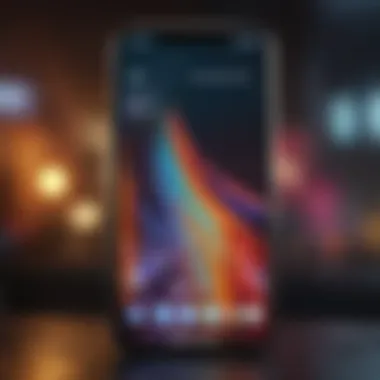Exploring the Largest Phone Screens: A Comprehensive Analysis


Intro
The evolution of smartphone screens is a fascinating aspect of technology that reflects changes in consumer behavior and preferences. In recent years, the trend toward larger displays has become pronounced, impacting how users interact with their devices. With a growing number of smartphones featuring expansive screens, it becomes essential to understand the implications of this trend on usability and functionality. This article will explore key aspects of large smartphone displays, including their specifications, the various types available, and the practical effects on daily use.
In order to navigate this expansive topic, we will delve into the technical characteristics of large screens, assess their advantages and disadvantages, and provide insights into why consumers are gravitating toward these devices. We aim to equip readers with the knowledge needed to make informed decisions when selecting a smartphone that can cater to their lifestyle.
Overview of Large Smartphone Displays
Large smartphone displays offer a different experience compared to their smaller counterparts. They make it easier to consume content, play games, and perform multitasking activities.
Definition
A large smartphone display typically refers to devices with screens measuring over six inches diagonally. These screens enable users to view more information at once, enhancing productivity and entertainment.
Key Features
- High Resolution: Many large screens come with high-definition resolutions, such as Full HD or 4K, providing crisp visuals.
- Touch Sensitivity: Enhanced touch sensitivity allows for more precise interactions, especially in gaming and graphic design applications.
- Wide Color Gamuts: Improved color accuracy produces more vibrant images, which is especially beneficial for photo editing and media consumption.
Purpose and Benefits
Larger displays serve several purposes. They enhance media experiences by providing immersive visuals and make reading easier, especially for users with visual impairments. Furthermore, they can facilitate business tasks like video conferencing and document editing, appealing to professionals seeking to maximize productivity.
Types and Categories of Large Smartphone Displays
Understanding the types of large smartphone displays available can help consumers make more informed choices. Different categories exist, depending on various factors such as technology and features.
AMOLED vs.
- AMOLED: Often found in high-end devices, AMOLED screens provide richer colors and deeper blacks.
- LCD: Widely used across brands, LCD screens are typically more affordable but can lack the contrast of AMOLED.
Foldable Displays
Foldable smartphones have recently entered the market, allowing users to enjoy a compact device that can expand to a larger screen when needed. Brands like Samsung and Huawei lead in this innovation.
Pros and Cons
Pros
- Enhanced Viewing Experience: Larger screens enhance viewing, making it suitable for movies and gaming.
- Improved Multitasking: Users can run multiple apps simultaneously more effectively.
Cons
- Portability Issues: Larger devices can be cumbersome, making them less portable.
- Battery Drain: Larger displays may consume more battery power, requiring frequent charging.
End
In summary, the rise of large smartphone displays illustrates a shift in how people engage with technology. As consumers seek smarter, more efficient devices, understanding the variations in screen types and their respective advantages becomes crucial. The upcoming sections will further dissect these aspects, focusing on usability, ergonomics, and user-specific requirements.
Preface to Large Phone Screens
In recent years, the trend of larger smartphone screens has fundamentally reshaped how we interact with mobile devices. As the appetite for multimedia content grows, consumers seek devices that enhance their viewing experiences. This section aims to unpack the significance of large phone screens. We will discuss key elements, benefits, and considerations that define the landscape of large smartphones.
Defining Large Screens in the Smartphone Market
The notion of what constitutes a 'large' smartphone screen is somewhat fluid. Typically, screens measuring 6 inches or more diagonally fall into this category. In the current market, sizes exceeding 6.5 inches are increasingly common, particularly in flagship models. This definition is more than a mere number; it represents a shift in user preference. Large screens offer improved visibility and interactivity, benefiting activities like gaming, video watching, and multitasking.
The growth in this category reflects a clear consumer desire for more real estate. And this is not just about size; it's about the experience. Greater screen sizes allow for more immersive content, making it ideal for watching videos and playing games. With larger displays, brands are focusing on providing high-resolution screens that elevate these experiences further.
Historical Context of Phone Screen Sizes
The evolution of smartphone screen sizes can be traced back to early models. Initially, phones with 3-inch screens were considered innovative. However, as technology progressed, manufacturers began introducing larger displays, recognizing a trend that would lead to the modern smartphone.


In the early 2010s, the emergence of devices like the Samsung Galaxy S and Apple's iPhone 5 marked a pivotal transition. These models challenged the norm, introducing screens that exceeded 4 inches. As consumer usage patterns evolved, so did the dimensions of smartphone screens. By 2015, phones like the Samsung Galaxy Note series had popularized sizes around 5.5 inches and beyond.
Today’s market sees devices regularly exceeding 6.5 inches, a change driven by consumer demand for media consumption and the increasing integration of smartphones into daily life. This historical context is critical to understanding not only the current landscape but also the potential future of large phone screens.
Popular Models with the Biggest Screens
The rise of larger phone screens marks a significant shift in the smartphone industry. It reflects changing consumer preferences that favor enhanced multimedia experiences and more functional displays. This section provides an overview and in-depth review of current market leaders in large-screen smartphones, focusing on their impact, benefits, and usability considerations.
Overview of Current Market Leaders
The current landscape of smartphones with large screens is dominated by a few key players. Among these, Apple, Samsung, OnePlus, and Xiaomi have emerged as frontrunners. Each of these brands offers devices with distinctive features and specifications that cater to the needs of diverse users.
- Apple stands out with its iPhone series, known for exceptional build quality and user-friendly interfaces.
- Samsung Galaxy Note series is celebrated for its productivity features, catering particularly to professionals.
- OnePlus devices provide a balance of performance and price, appealing to budget-conscious consumers.
- Xiaomi's flagship phones deliver impressive specs at relatively lower prices, making them popular in emerging markets.
Market leaders are not only competing based on screen size but also in other areas, such as resolution and software optimization. This multifaceted approach plays a crucial role in determining consumer preferences.
In-Depth Review of Selected Devices
Apple's iPhone Series
The iPhone series, particularly the Pro models, is notable for its brilliant Retina Display. The quality of this display is a key aspect that enhances the overall user experience. The high pixel density is beneficial for clear and vivid visuals, which is essential for activities like photo editing and video streaming.
A unique feature of the iPhone series is its seamless integration with iOS software. This ensures that apps are optimized for large screens, providing a smooth user experience. However, the premium price of these devices may be a drawback for some, especially if budget is a key consideration.
Samsung Galaxy Note Series
The Samsung Galaxy Note series has carved a niche for itself with its large screens and the inclusion of the S Pen. This stylus allows for precise input and enhances productivity, making it a favored choice for professionals and creative individuals. The display technology used in Note devices, particularly Super AMOLED, offers remarkable contrast and vibrant colors.
The mixed reviews about usability primarily hinge on the size of the devices. While a large screen is advantageous for many tasks, it can be cumbersome for one-handed use. Nonetheless, the Note series remains a popular choice due to its robust functionality and versatility.
OnePlus Devices
OnePlus devices have gained traction for their competitive pricing without sacrificing quality. Large displays featuring AMOLED technology deliver good brightness and color accuracy, appealing to multimedia users. OnePlus is known for its OxygenOS, which is clean and user-friendly.
Users often regard OnePlus devices as a strong value option. However, they sometimes lack some premium features found in higher-priced competitors, which may influence decisions for tech enthusiasts seeking the latest technology.
Xiaomi's Flagship Phones
Xiaomi's flagship phones, such as the Mi series, are recognized for their value. They often provide large screens with impressive specifications at a fraction of the cost of other brands. With displays like AMOLED and increasing refresh rates, they cater well to both media consumption and gaming needs.
However, the software experience on some devices may be inconsistent compared to more established brands, leading to mixed user experiences. Still, the aggressive pricing strategy of Xiaomi attracts a growing number of users, especially in price-sensitive markets.
All these models illustrate various aspects of large-screen usability and design. The right choice ultimately depends on individual needs and preferences.
Screen Specifications and Performance
Screen specifications and performance are fundamental aspects in the evaluation of large phone screens. Consumers today are increasingly informed and discerning, seeking devices that not only offer expansive displays but also provide an enriching experience through high-quality specifications. This section reviews important elements like resolution, display quality, refresh rates, and screen technology, which significantly impact user satisfaction and functionality.
Resolution and Display Quality
Resolution defines the clarity and detail of images displayed on a screen. The higher the resolution, the sharper and clearer the visuals will be. Current trends lean towards Full HD (1920x1080 with 441 ppi), Quad HD (2560x1440), and even 4K (3840x2160) resolutions. These levels enhance everything from watching videos to gaming, accommodating a range of multimedia content that users engage with daily.
Moreover, display quality encompasses a range of factors like color accuracy and brightness. Considerably brighter screens can reduce glare under direct sunlight, making outdoor usage more feasible.
Good resolution and display quality combine to create an immersive user experience.
Impact of Screen Technology
OLED vs.
Displays
The dueling technologies of OLED and LCD dominate the smartphone display market. OLED displays are recognized for their rich colors and deeper blacks, offering a contrast ratio that enhances video and photo quality. Commonly used in devices from companies like Samsung, they are particularly popular for viewing dynamic content, such as movies and games.


However, LCD displays still hold significance, especially in reducing manufacturing costs. They produce good color accuracy but often fall short in contrast levels. While OLED technology has its advantages, some may find LCD satisfactory, depending on their usage scenarios.
Refresh Rates and User Experience
Refresh rates, measured in Hertz (Hz), determine how many times a screen refreshes its image per second. A higher refresh rate, such as 120Hz or 144Hz, results in smoother scrolling and improved performance in fast-paced activities like gaming. This crucial aspect enhances overall user experience and makes for a more seamless interaction when navigating applications.
Nevertheless, users must consider the potential impacts on battery life. Devices with high refresh rates can drain batteries faster, which could be a disadvantage for those who depend on their phones throughout the day.
Understanding the nuances between these screen characteristics is essential for discerning consumers looking to make informed buying decisions.
Usability Considerations for Large Screens
Large screens in smartphones bring various usability considerations. They enhance user experience but also present challenges. Understanding these factors is crucial for anyone looking for large-display devices.
Ergonomics and Device Handling
Ergonomics plays a significant role when choosing smartphones. A larger screen can improve viewing and interaction but can affect how the device is handled. Balance is essential. Ideally, the phone should feel comfortable in one hand, while also allowing for easy access to all screen areas.
For users, the grip is crucial. Large phones often require adjustments in how they are held. Moreover, heavy devices can cause hand fatigue. Hence, weight is a factor that should be considered when choosing a large phone display. A good practice is to hold the device for a while before buying, to gauge comfort and user-friendliness.
One-Handed vs.
Two-Handed Use
Another consideration is how users interact with larger screens. Many people often have to choose between one-handed and two-handed use. One-handed use is convenient for quick tasks, but it may become cumbersome on large screens. It may lead to multiple awkward motions to reach different parts of the screen.
In contrast, using both hands makes it easier to operate the device. This allows the user to navigate larger screens without stretching fingers uncomfortably. Features like swipe gestures assist one-handed use but often have limitations. Devices like Apple's iPhone models or Samsung's Galaxy Note series come equipped with options that help users better manage large screens.
A larger display offers enormous benefits, but neglecting to consider ergonomics can diminish those advantages.
Consumer Preferences and Market Trends
Understanding consumer preferences in the smartphone market is essential in the era of rapidly evolving technology. Large phone screens have become a focal point for many users due to the enhanced functionality they offer. This section explores the shift in user choices towards larger display devices and examines how these preferences shape market trends.
Demographic Insights on Large Screen Users
User demographics play a critical role in understanding the popularity of large screens. Research shows that young professionals, families, and students are the primary demographics promoting this trend.
- Young Professionals: They often prioritize productivity and multitasking features. A larger screen allows easier navigation of emails, documents, and various apps without feeling cramped.
- Families: For family use, larger screens offer shared experiences, whether watching movies, playing games, or surfing the web together. Exhibiting a communal approach to mobile entertainment is a growing trend.
- Students: With increased reliance on digital resources and online learning, larger displays cater to the need for reading, note-taking, and interactive learning tools.
Moreover, users in different regions may show varying levels of preference for large screens. For instance, in areas where mobile gaming is popular, larger screens tend to attract more users. This indicates the importance of tailoring marketing strategies to address specific demographic needs, which in turn impacts device design and release strategies.
Trends in Smartphone Design and Display Size
Smartphone design is continually influenced by consumer preferences. The rise of large screens has led manufacturers to innovate, pushing the boundaries of device capabilities and aesthetics.
- Aspect Ratios: Manufacturers are experimenting with aspect ratios to balance display size and usability. Wider and taller screens are becoming mainstay features to enhance the viewing experience.
- Thin Bezels: Companies strive to minimize bezels, allowing for larger screens without significantly increasing device size. It is common to see flagship models with a nearly edge-to-edge display, maximizing screen real estate.
- Foldable Devices: Emerging technologies are paving the way for foldable smartphones, which can feature large screens without compromising portability. This technology caters to users seeking both a compact device and an expansive display.
As consumer preferences continue to shift toward larger displays, manufacturers must adapt their strategies. Meeting the demand of functionality, ergonomic handling, and aesthetic appeal is crucial.
“The direction of smartphone design is heavily influenced by user expectations for larger, richer displays.”
In summary, recognizing consumer preferences and market trends is essential for understanding the growing popularity of large phone screens. Demographic insights guide manufacturers in product development while trends in smartphone design reflect the evolving landscape of user needs.
Benefits of Large Phone Screens
The significant trend towards larger phone screens is not merely a market gimmick; it offers palpable benefits that directly impact user experience. In this section, we will explore the advantages of opting for a smartphone with a larger display, covering how these screens improve functionality, usability, and overall satisfaction for diverse user groups.
Enhanced Viewing Experience
One of the most notable advantages of large phone screens is the enhanced viewing experience they provide. Whether it is watching videos, browsing the web, or reading articles, larger screens allow for better visibility. Users can enjoy sharper images and more vibrant colors, which are critical for activities like gaming and streaming.
For instance, devices like Samsung Galaxy S23 Ultra come with displays that boast impressive resolution and color accuracy. The larger surface area reduces eye strain since users do not have to squint or zoom in to see finer details. This improvement in visibility can make a considerable difference during long sessions of media consumption or reading, contributing to a more enjoyable user experience.


Multimedia Consumption and Gaming
Large screens have transformed the way people interact with multimedia content. The popularity of streaming services has surged, and larger displays complement this trend by providing an immersive experience. With a vast array of platforms available for viewing, such as Netflix or YouTube, having a spacious screen can significantly enhance the enjoyment of these activities.
Gaming is another area where large phone screens shine. Many modern mobile games utilize intricate graphics and detailed designs. A larger display allows players to appreciate these features fully, improving their engagement and satisfaction during gameplay.
Moreover, the combination of a larger screen and high refresh rates found in devices like the ASUS ROG Phone 6 supports a smoother experience. Higher refresh rates reduce motion blur, enhancing the visual fluidity during fast-paced gameplay. This capability is crucial in competitive gaming scenarios, giving users an edge and elevating their experience.
Ultimately, selecting a smartphone with a large screen is not only about size but also about the overall enhancement in usability, enjoyment, and functionality.
Drawbacks of Large Phone Screens
The rise of large smartphone screens is undeniable, but this trend comes with its own set of challenges. Understanding the drawbacks of these devices is essential for consumers to make informed choices. This section will delve into the specific issues related to portability and battery life that impact the usability and practicality of large-screen smartphones.
Portability Challenges
One of the significant concerns with large phone screens is their portability. Larger devices can be more cumbersome to carry. For many young professionals and students, a sleek and lightweight phone is ideal, especially when juggling various tasks throughout the day. When the phone is too large, it often becomes difficult to fit into pockets or small bags.
- Weight and Size: Phones like the Samsung Galaxy S23 Ultra, while offering impressive displays, often weigh more than their smaller counterparts. This added weight can lead to discomfort during prolonged carrying.
- One-Handed Use: The size of large screens limits the ability to operate the phone with one hand, which can be inconvenient in fast-paced environments like public transport or while multitasking. Users may find themselves needing two hands even for simple tasks like texting.
Battery Life Considerations
As screen sizes increase, so does the demand for power. While many large-screen phones come equipped with larger batteries, the impact on battery life is significant. Users should consider how longer screen-on time can lead to reduced battery efficiency over the lifespan of the device.
- Draining Effects: Larger screens consume more energy, especially when used for high-intensity tasks such as gaming or video streaming. Devices such as the iPhone 15 Pro Max are known for this trend. Users may find themselves charging their phones more frequently than they would prefer.
- Increased Usage Patterns: With a larger screen, users often engage more with media and applications. This can quickly lead to battery depletion, influencing how users integrate charging habits into their daily routines.
Understanding the trade-offs involved in owning a large-screen device can help users align their choices with their lifestyle needs.
Future of Large Phone Screens
The future of large phone screens is a pivotal aspect in the ongoing evolution of smartphone technology. As screen sizes continue to increase, understanding the dynamics surrounding this trend is vital. This section will explore how emerging technologies, user expectations, and innovations shape the future of smartphones. The impact of these factors extends beyond mere dimensions, influencing usability, functionality, and market strategies. Recognizing these aspects can help consumers and industry professionals alike grasp the potential developments in this fast-evolving landscape.
Emerging Technologies in Display Design
In recent years, we have seen significant advancements in display technology that enhance the visual experience on large phone screens. Innovations such as flexible OLED displays and microLED technology are redefining what large displays can offer. Unlike traditional LCD, OLED provides deeper blacks and vibrant colors, leading to a more engaging viewing experience.
- Flexible Displays: This technology allows smartphones to have bends and folds without compromising functionality. Devices like Samsung's Galaxy Z Fold are prime examples of this trend.
- MicroLED: MicroLED displays are smaller and more efficient than OLEDs, offering better brightness and energy consumption. The potential for integration into larger devices presents exciting possibilities.
Each innovative step moves the industry closer to a future where display technology significantly enhances usability and user interaction. Consumers are now anticipating smarter, thinner, and more responsive screens.
Consumer Expectations and Innovations
As large phone screens become standard, user expectations evolve continually. Consumers are looking for not only bigger screens but also advanced features that enhance the overall experience.
Two main consumer demands are driving innovation:
- Higher Resolution: Users expect displays with ultra-high-definition resolution, as it directly impacts the clarity and detail of content.
- Robust Performance: With larger displays, smartphones must maintain strong performance while offering smooth multitasking capabilities. Features like better processing power and RAM are essential, influencing purchase decisions.
Quote:
Epilogue
The topic of large phone screens holds significant importance in understanding the evolving landscape of smartphones. With the shift towards larger displays, users are presented with a range of benefits and considerations. Notably, consumer experiences have changed as larger screens provide enhanced visual engagement and functionality in various activities ranging from media consumption to productivity tasks.
Summary of Key Insights
In this article, we explored several pivotal aspects associated with large phone screens. Key insights include:
- Consumer Preferences: There has been a noticeable trend toward larger displays, with users valuing the immersive experience they provide.
- Usability Factors: While large screens can enhance user experience, they also raise questions regarding device handling and portability.
- Market Innovations: Manufacturers are continuously innovating screen technologies, introducing features such as OLED displays and high refresh rates that improve visual quality and responsiveness.
These insights help to explain the trend towards larger devices and their impact on daily usage and consumer choices.
Personalizing Choices Based on Needs
When selecting a smartphone, it is crucial for individuals to assess their specific requirements. What may be ideal for one user may not suit another. Here are some factors to consider:
- Daily Activities: Analyze how you primarily use your smartphone. For heavy media consumers or gamers, larger displays might offer a better experience.
- Ergonomics: Consider how comfortable it is to use the device. If you often use your phone with one hand, screen size and weight are vital.
- Battery Life: A larger screen may consume more battery. Users should look for models that balance display size with longer battery life.
Personalizing device choices based on these elements ensures that users select a smartphone that fits their lifestyle and enhances their interactions with technology.



